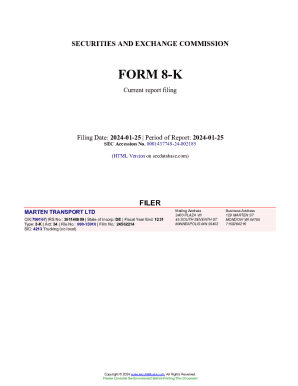Analyzing Proxy Statements (Form DEF 14A): Key Information And Insights

Table of Contents
Understanding the Structure of a Proxy Statement (Form DEF 14A)
Proxy statements, also known as Form DEF 14A filings, are complex documents, but understanding their structure is the first step to effective analysis. Navigating these filings efficiently allows investors to extract valuable information pertinent to their investment strategy.
Key Sections and Their Importance:
Proxy statements typically include several key sections:
-
Executive Compensation: This section provides a detailed breakdown of salaries, bonuses, stock options, restricted stock units (RSUs), and other benefits received by top executives. Analyzing this data allows you to compare executive pay to industry benchmarks and assess whether compensation is excessive or appropriately tied to company performance. Look for alarming trends and consider whether incentives are aligned with long-term shareholder value creation. Scrutinize the methodology used to determine executive compensation and identify any potential conflicts of interest.
-
Board of Directors: This section details the composition of the board, including director biographies, their experience, independence (crucial for objective decision-making), and committee assignments (audit, compensation, nominating, etc.). Analyze board diversity, considering factors such as gender, race, and expertise. A diverse and independent board often signals stronger corporate governance.
-
Shareholder Proposals: This section outlines proposals submitted by shareholders, offering insights into pressing corporate governance issues and shareholder concerns. Carefully review both the proposals and management's recommendations. This section provides a gauge of shareholder activism and the company's response to it.
-
Mergers and Acquisitions: If a company is involved in a proposed merger, acquisition, or other significant corporate transaction, the proxy statement will provide detailed information, including the rationale behind the deal, financial terms, and potential impact on shareholders. Thorough analysis here is crucial to understanding the potential risks and rewards associated with the transaction.
-
Auditor Information: This section provides information about the company's independent auditor and audit fees. Pay close attention to any changes in auditors or significant increases in audit fees, which may indicate potential conflicts of interest or underlying issues.
Identifying Key Financial Metrics:
Beyond the qualitative information, proxy statements often include or reference key financial metrics. These provide a quantitative view of the company's financial health.
-
Analyze key performance indicators (KPIs) such as revenue growth, profitability margins (gross profit margin, operating margin, net profit margin), earnings per share (EPS), return on equity (ROE), and debt-to-equity ratio. Comparing these figures to previous years and industry averages provides valuable context.
-
Pay close attention to any significant changes in these metrics. Large swings might indicate underlying business challenges or opportunities that warrant further investigation.
Analyzing Executive Compensation in Proxy Statements
Executive compensation is a key area of focus in proxy statement analysis. Understanding the compensation structure helps determine if executives are properly incentivized and if their pay is justified by company performance.
Identifying Potential Red Flags:
Certain aspects of executive compensation can raise concerns:
-
Excessive CEO-to-worker pay ratios: A disproportionately high ratio may indicate a misalignment of interests between management and employees.
-
Lack of performance-based compensation: Compensation structures that lack a significant performance component can suggest that executives are not held accountable for their results.
-
Golden parachutes and other lucrative severance packages: These can discourage accountability and encourage risky behavior, as executives are cushioned from the consequences of poor performance.
-
Backdating of stock options: This illegal practice artificially inflates the value of stock options, enriching executives at the expense of shareholders.
Using Compensation Data for Investment Decisions:
Analyzing executive compensation allows investors to make more informed decisions:
-
Compare executive compensation to company performance: A strong correlation between pay and performance indicates effective incentive alignment.
-
Assess the alignment of executive incentives with shareholder interests: Does the compensation structure encourage long-term value creation or short-term gains at the expense of the company's long-term prospects?
-
Consider the overall compensation structure: A holistic view of salary, bonuses, stock options, and other benefits helps evaluate the total compensation package and its potential impact on long-term value creation.
Utilizing Proxy Statements for Corporate Governance Analysis
Corporate governance is critical for long-term shareholder value. Proxy statements offer insights into how well a company manages its governance.
Assessing Board Independence and Effectiveness:
A strong board of directors is essential for sound corporate governance. Proxy statements allow investors to assess board effectiveness:
-
Evaluate the percentage of independent directors: A high percentage of independent directors suggests a reduced risk of conflicts of interest.
-
Analyze the board's committees: Effective audit, compensation, and nominating committees are crucial for overseeing risk management, executive pay, and director selection.
-
Look for conflicts of interest: Identify any potential conflicts of interest that might influence board decisions.
Understanding Shareholder Rights and Activism:
Proxy statements reveal the level of shareholder engagement and activism:
-
Identify shareholder proposals and management responses: This indicates the level of shareholder involvement and the company's responsiveness to shareholder concerns.
-
Gauge the level of shareholder engagement: High shareholder engagement usually signifies a company that values its investors' input.
-
Assess the company's responsiveness to shareholder concerns: A company's response to shareholder proposals provides insights into its commitment to good corporate governance.
Accessing and Interpreting Proxy Statements (Form DEF 14A)
Finding and effectively using proxy statements is crucial for leveraging their wealth of information.
Locating Proxy Statements:
Proxy statements are publicly available through several channels:
-
SEC EDGAR database: The primary source for all SEC filings, including Form DEF 14A. The SEC's EDGAR database (Electronic Data Gathering, Analysis, and Retrieval system) is a free and invaluable resource.
-
Company investor relations websites: Most public companies post their proxy statements on their investor relations pages, often making them easily accessible.
Tools and Resources for Analysis:
Analyzing large datasets within proxy statements can be challenging. Consider using these tools:
-
Specialized financial data providers: Many financial data providers offer tools to analyze corporate filings, including proxy statements. These tools can automate data extraction and analysis, saving considerable time and effort.
-
Spreadsheet software: Spreadsheet software such as Microsoft Excel or Google Sheets can be helpful for organizing and analyzing data extracted from proxy statements.
Conclusion
Analyzing proxy statements (Form DEF 14A) is a crucial step in conducting thorough due diligence and making informed investment decisions. By understanding the structure, key sections, and potential red flags within these documents, investors can gain valuable insights into a company's corporate governance, executive compensation, and financial performance. Remember to utilize the resources available to effectively analyze these complex documents. Mastering the art of analyzing proxy statements (Form DEF 14A) is key to successful long-term investing. Start analyzing proxy statements today and improve your investment strategy!

Featured Posts
-
 Moto Racing News Gncc Mx Sx Flat Track And Enduro Coverage
May 17, 2025
Moto Racing News Gncc Mx Sx Flat Track And Enduro Coverage
May 17, 2025 -
 Nba Playoffs 76ers Vs Celtics Prediction And Analysis
May 17, 2025
Nba Playoffs 76ers Vs Celtics Prediction And Analysis
May 17, 2025 -
 Iznenadenje U Barseloni Rune Pobeduje Povredenog Alkarasa
May 17, 2025
Iznenadenje U Barseloni Rune Pobeduje Povredenog Alkarasa
May 17, 2025 -
 Ubers April Surge A Double Digit Rally Explained
May 17, 2025
Ubers April Surge A Double Digit Rally Explained
May 17, 2025 -
 Severance Season 3 Renewal What We Know
May 17, 2025
Severance Season 3 Renewal What We Know
May 17, 2025
Latest Posts
-
 Get Your Boston Celtics Championship Gear Under 20 Today
May 17, 2025
Get Your Boston Celtics Championship Gear Under 20 Today
May 17, 2025 -
 Secure Your Boston Celtics Finals Gear Prices Under 20
May 17, 2025
Secure Your Boston Celtics Finals Gear Prices Under 20
May 17, 2025 -
 Knicks Offensive Woes Brunsons Return And The Road To Recovery
May 17, 2025
Knicks Offensive Woes Brunsons Return And The Road To Recovery
May 17, 2025 -
 Limited Time Boston Celtics Finals Gear For Less Than 20
May 17, 2025
Limited Time Boston Celtics Finals Gear For Less Than 20
May 17, 2025 -
 Assessing The Damage Comparing The Impact Of Jalen Brunsons And A Hypothetical Luka Doncics Departure From The Mavericks
May 17, 2025
Assessing The Damage Comparing The Impact Of Jalen Brunsons And A Hypothetical Luka Doncics Departure From The Mavericks
May 17, 2025
